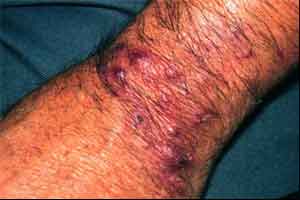- Home
- Editorial
- News
- Practice Guidelines
- Anesthesiology Guidelines
- Cancer Guidelines
- Cardiac Sciences Guidelines
- Critical Care Guidelines
- Dentistry Guidelines
- Dermatology Guidelines
- Diabetes and Endo Guidelines
- Diagnostics Guidelines
- ENT Guidelines
- Featured Practice Guidelines
- Gastroenterology Guidelines
- Geriatrics Guidelines
- Medicine Guidelines
- Nephrology Guidelines
- Neurosciences Guidelines
- Obs and Gynae Guidelines
- Ophthalmology Guidelines
- Orthopaedics Guidelines
- Paediatrics Guidelines
- Psychiatry Guidelines
- Pulmonology Guidelines
- Radiology Guidelines
- Surgery Guidelines
- Urology Guidelines
Rose thorn injury

A 71-year-old man, with a history of arterial hypertension, presented with a 4-month history of four painful progressively enlarging nodules on the dorsal aspect of the right hand.
The patient reported that he had been pricked by a rose on the fourth finger approximately 3 weeks before the appearance of the first lesion on the site of the injury. On physical examination, we observed four erythematous nodules, 10–15 mm in diameter, in linear distribution extending from the hand proximally . Two nodules presented superficial erosions with purulent secretion. No systemic symptoms were detected.
Histopathology revealed epidermal hyperkeratosis and suppurative small granulomas with polymorphous dermal infiltrate and periodic acid-Schiff staining identified rare fungal spores. Culture from the biopsy specimen was negative. Clinical presentation and histology were consistent with sporotrichosis, so the patient was given itraconazole 200 mg daily. After 3 months of treatment, only a mild improvement was observed; therefore, the dose was escalated to 200 mg twice daily during following 4 months with complete resolution of 3 lesions. The fourth lesion was excised completely. There was no recurrence of the disease after 2-year follow-up.
Sporotrichosis is a rare chronic granulomatous mycotic infection caused by a bimorphic fungus Sporothrix schenckii. The most common form of sporotrichosis is a lymphocutaneous infection, which is caused by traumatic inoculation from contaminated plants, soil or through zoonotic transmission.
The diagnosis of sporotrichosis is based on clinical presentation, epidemiological context together with laboratory studies (direct examination, culture and tissue histopathology).
Itraconazole 200 mg daily for at least 3–6 months is the treatment of choice for the lymphocutaneous disease. Non-responders should be given itraconazole 200 mg twice daily, terbinafine 500 mg twice daily or saturated solution of potassium iodide if itraconazole is not available. Possible adverse side effects of the prolonged systemic antifungal treatment (headache, gastrointestinal, dermatological manifestation) or prolonged potassium iodide administration (endocrine, gastrointestinal and renal) require careful clinical and laboratory monitoring.

Disclaimer: This site is primarily intended for healthcare professionals. Any content/information on this website does not replace the advice of medical and/or health professionals and should not be construed as medical/diagnostic advice/endorsement or prescription. Use of this site is subject to our terms of use, privacy policy, advertisement policy. © 2020 Minerva Medical Treatment Pvt Ltd